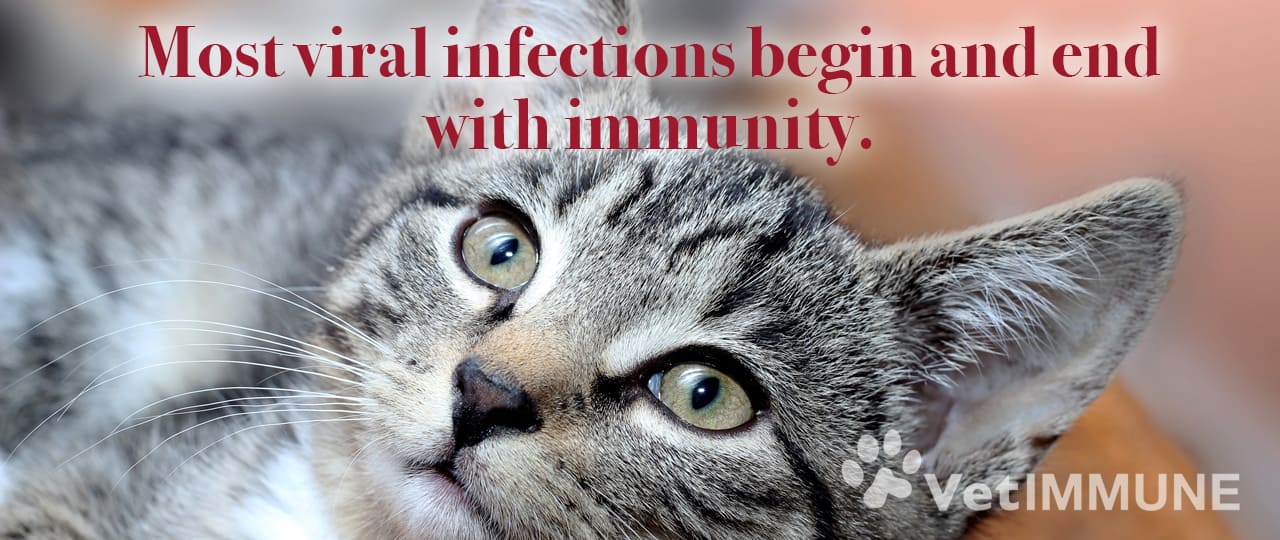
3 – Viral diseases and the immunomodulatory approach.
Immunostimulating (immunomodulatory) medicines are a new, cutting edge development designed to rebuild the damaged immunity and direct it against the invading viruses. In some instances, an antiviral drug may be needed in addition to an immunostimulant drug, but won’t replace it, because suppressing the agent of the disease does not restore the immune system. If immunity has been wiped out, cats feel equally bad regardless of the viral load. Remember how long it takes to get back to your normal self after a head cold or the flu? It’s the same with cats. A medicine that stimulates or modulates immunity helps the body fight the disease; it also regulates the strength of the immune response, aims to correct the damaged immune system and bring it back to a healthy status.
Another notable benefit of immunomodulatory therapy is the elimination of the feeling of sickness – a by-product of the disease – As immunity improves, the cat starts feeling better and happier.
Many veterinary specialists agree that immunomodulation is imperative with viral diseases that cause massive damage to immunity. Most viral infections start and end with immunity. A viral disease begins with the virus evading the weakened immunity of an immuno-compromised cat and ends when the restored immunity controls or suppresses the virus.
Examples of such diseases include:
• Feline viral rhinotracheitis (FVR) caused by a herpesvirus;
• Feline infectious peritonitis (FIP), an immune-mediated disease triggered by the mutation of a feline enteric coronavirus (FCoV);
• Feline leukemia virus (FeLV), which impairs multiple immune functions;
• Feline immunodeficiency virus (FIV), to name only a few.
A viral disease begins with the virus evading the weakened immunity of an immuno-compromised cat and ends when the restored immunity controls or suppresses the virus.
The consensus about an effective treatment for feline infectious peritonitis (FIP) is that while attempts are being made to find antiviral drugs that will slow down the replication of the virus, the most promising approach is to combine an antiviral and an immune response modifier.
“To destroy invaders, the immune system must first recognize them. It can make this distinction because all cells have unique markers on their surface that identify them. A cell with markers on its surface that are not identical to those on the body’s own cells is identified as being foreign. The immune system then attacks that cell […] Nonspecific (innate) immunity is present at birth. It is so named because its components treat all foreign substances in much the same way. Acute inflammation is the most important process involved in nonspecific immunity. During inflammation, white blood cells (such as neutrophils and macrophages) rapidly travel from the blood into the tissues to kill invading organisms and remove injured cells. Other white blood cells involved in nonspecific immunity are monocytes (which develop into macrophages), eosinophils, basophils, and natural killer cells. These nonspecific types of white blood cells usually act on their own to destroy invaders. The complement system and cytokines are molecules produced by the immune system that also participate in nonspecific immunity.”
Source: Merck Vet Manual
Polyprenyl Immunostimulant™ (a.k.a. PI or PPI) triggers an innate immune antiviral response, which is the only defense against the virus in a non-immunized cat. The signal that PI conveys to the cells alerts them to start fighting the invader even if they are blind to the invasion.
The consensus about an effective treatment for feline infectious peritonitis (FIP) is that while attempts are being made to find antiviral drugs that will slow down the replication of the virus, the most promising approach is to combine an antiviral and an immune response modifier.
In the US, immunity modulation/stimulation using Polyprenyl Immunostimulant™ was pioneered in the early 2000s by Dr. A.M. Legendre, DVM, who tested Polyprenyl Immunostimulant™ in feline viral diseases like feline viral rhinotracheitis (FVR), a common and ubiquitous upper respiratory infection (URI); and feline infectious peritonitis (FIP).
Experts in virology agree that innate cellular immunity is central to the control or elimination of the virus in the body. Polyprenyl Immunostimulant™ belongs to the class of signaling molecules and triggers innate cellular immunity through Toll-receptors 1, which activate defenses by different immunity cells. PI is a unique treatment in veterinary medicine – no similars or analogs exist.
Herpesvirus, which causes feline rhinotracheitis, is a latent infection with periodic flareups. It cannot be cured; it can only be controlled so that the cat does not experience the upper respiratory infection (URI) signs responsible for the feeling and behavior of being sick. All herpesviruses sabotage immune responses. Sickness behavior comes from a lack of proper immune response [Tizad, 2008, Animal Health Res Rev 9; 87-99]. While direct antiviral may lessen the viral load during flareups, cats do not read the viral titer report. If their immunity has been annihilated, cats feel equally bad regardless of viral load.
Polyprenyl Immunostimulant™ is the only therapeutic approved by the USDA for the treatment of feline rhinotracheitis. It reduces the severity of the disease in cats and very safe (zero side-effects), well-tolerated oral liquid designed with cats in mind. Polyprenyl Immunostimulant™ reduces clinical signs and alleviates the feeling of sickness by restoring an adequate immune response. Our numerous user surveys show Polyprenyl Immunostimulant™ makes cats happy, energetic, and returns them to their healthy selves.
Feline Infectious Peritonitis (FIP) is a devastating disease caused by a mutated form of feline coronavirus that triggers a global immunity failure in cats. FIP has long been considered an incurable, fatal disease. The way clinical FIP develops as an immune-mediated disease is unique. Interaction between the body’s own immune system and the virus is responsible for the disease.
